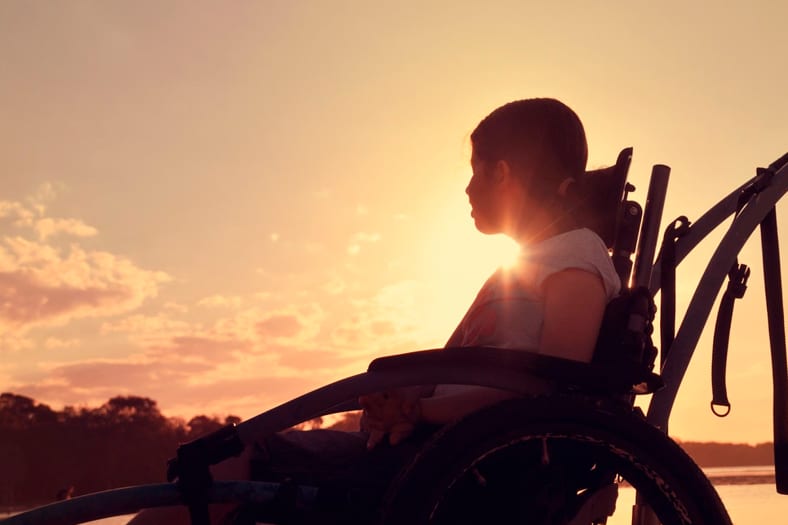
What Is Cerebral Palsy?
The Centers for Disease Control and Prevention (CDC) defines Cerebral Palsy as “a group of disorders that affect a person’s ability to move and maintain balance and posture.” Cerebral Palsy symptoms are not necessarily the same for everyone and can vary among those who are diagnosed with the condition.
Some people with cerebral palsy may be capable of movement and taking care of themselves independently, while others may be entirely incapable of walking on their own and require a caregiver to assist on a daily basis. Regardless of the extent a person experiences Cerebral Palsy symptoms, anyone with the condition will have difficulty with their posture and movement. According to the CDC, Cerebral Palsy is the most common motor disability in childhood.
What are the causes of Cerebral Palsy?
The CDC explains that Cerebral Palsy is “caused by abnormal brain development or damage to the developing brain that affects a person’s ability to control his or her muscles.” This abnormal brain development can occur before the person is born, during childbirth, or at any point within the person’s first year of life. These stages are all crucial points for a person’s brain development, hence the reason a child is more susceptible to brain damage or a condition like cerebral palsy.
Cerebral Palsy is sometimes a result of medical negligence that may occur during the labor and delivery process of childbirth. Although medical negligence may not be the cause of all cases of Cerebral Palsy, it can be a catastrophic birth injury that may be compensated for by a cerebral palsy lawsuit.
If you believe you or your loved one has suffered a birth injury from medical negligence,
contact our catastrophic injury attorneys today.
Types of Cerebral Palsy
It is important to understand that there are four main types of Cerebral Palsy:
- Spastic Cerebral Palsy: This is the most common type of Cerebral Palsy — nearly 80% of people with Cerebral Palsy struggle from Spastic Cerebral Palsy. Those who have this type experience stiff muscles, which results in awkward movements. Spastic Cerebral Palsy can range from affecting only one side of a person’s body to affecting all four limbs and the face. Not only does Spastic Cerebral Palsy impact a person’s movement, but the most severe form can result in intellectual disabilities and more.
- Dyskinetic Cerebral Palsy: This type of Cerebral Palsy sees people struggle to control their ability to move their limbs. This can result in difficulty with simple skills such as walking or even sitting. Unlike the stiffened muscle tone caused by Spastic Cerebral Palsy, a person with Dyskinetic Cerebral Palsy can see their muscle tone change drastically between being too loose or too tight.
- Ataxic Cerebral Palsy: Balance and coordination difficulties are common among those who have Ataxic Cerebral Palsy. The most common issues people with Ataxic Cerebral Palsy encounter are with quick movement and control.
- Mixed Cerebral Palsy: A person is categorized as having Mixed Cerebral Palsy when they display symptoms from more than one of the three aforementioned types.
These four categories allow doctors to better understand the extent to which a person is affected by Cerebral Palsy. Each type of cerebral palsy impacts a specific part of the brain, thus impacting the symptoms a person may experience.
What are the symptoms of Cerebral Palsy?
As mentioned earlier, difficulty with movement and posture are the main symptoms of Cerebral Palsy. In addition to struggling with movement and posture, other common symptoms of Cerebral Palsy include seizures, intellectual disability, spinal or joint problems, neurological issues, and difficulties related to speech, vision, or hearing.
Since Cerebral Palsy occurs within the first year of life while the child’s brain is developing, it’s essential to be aware of early signs of the condition in order to properly diagnose and treat your child’s symptoms.
Screening and diagnosis of Cerebral Palsy
By understanding the early signs of Cerebral Palsy, screening and diagnosing the conditions can often be done faster and easier. Developmental monitoring is essential to determining whether your child might have cerebral palsy. Developmental monitoring requires you to track your child’s growth and development over a certain period of time.
Should you notice any concerns during the developmental monitoring, then developmental screening is the next step. During this screening, your child’s developmental delays and movement delays will be assessed through a short test.
If your medical provider deems that a concern has arisen during the developmental screening test, then your child will require medical evaluations to determine whether they have Cerebral Palsy or a different condition. These medical evaluations may include brain scans, laboratory tests, and other cognitive tests.
How To Treat Cerebral Palsy

Although Cerebral Palsy cannot be entirely cured, there are many treatments and therapies available to those who are affected by the condition. Cerebral Palsy treatments are often geared toward making the patient able to live more comfortably with the condition. Treatments vary among patients and may include any of the following:
- Medications to lessen muscle tightness or combat seizures
- Various therapies to improve movement or speech
- Surgeries to correct bone abnormalities or relieve tight muscles
While there are many more potential treatments for Cerebral Palsy, the course of treatment may look different from patient to patient, given the vast array of symptoms and medical issues that can arise for people with Cerebral Palsy. Despite these treatments being unable to entirely rid an individual of Cerebral Palsy, proper treatment may decrease discomfort and increase a person’s life span.
Can Cerebral Palsy be Prevented?
Unfortunately, medical professionals have yet to discover how to fully prevent Cerebral Palsy, given how little is understood about the exact cause of the condition. While there are preventative measures that can be taken by parents and their healthcare providers, there is no guaranteed way to prevent a child from developing Cerebral Palsy.
Being an attentive and healthy parent during pregnancy is the best thing a person can do to ensure giving birth to a healthy baby. Further, preventing any head injuries during the baby’s early development is essential to guaranteeing they lead a healthy life.
While there is no guaranteed way for parents to prevent cerebral palsy during pregnancy, there are more preventative measures that can be taken by healthcare providers during labor and delivery to try to prevent the baby from suffering a brain injury.
Should a medical professional fail to abide by the appropriate standards of care while delivering a child, the child is more likely to suffer from a cerebral palsy birth injury. If a child suffered brain damage as a result of medical errors, it is likely that the birth injury could have been prevented.
How long do I have to file a Birth Injury claim?
If you are considering filing a birth injury claim due to medical malpractice, it’s important to be aware of the statute of limitations in your jurisdiction. Birth injury claims often have a long period in which they can be filed due to the unique nature of the claims. Birth injury cases can be brought by either the parents or the child, as both have their own separate legal claims.
The statute of limitations periods may differ between the parental claims and the child’s claims. In most states, the parents have a 2-year statute of limitations to bring the case. This period typically begins once the birth injury has occurred. The parents’ birth injury case may award them with damages for the costs of medical expenses and raising the child. These damages are calculated to provide financial support to the parents until the child turns 18.
The child’s claim, on the other hand, may still be filed after they have turned 18. The damages that the injured child can sue for in birth injury lawsuits include future medical expenses and loss of future earnings.
How Our Catastrophic Injury Lawyers Can Help To Prove Medical Negligence in a Birth Injury Lawsuit

While birth injury-caused cerebral palsy can be a difficult and scary time for many parents and children, getting in touch with a birth injury lawyer can relieve an immense amount of stress. The injury attorneys at Bachus & Schanker are fully equipped to handle the most severe cerebral palsy cases and birth injury cases. A birth injury lawyer will walk you through the steps of proving medical negligence and malpractice while fighting for your rights.
These Cerebral Palsy attorneys will use your child’s medical records and other factors to prove medical negligence on behalf of the labor and delivery staff that was present for your child’s birth. In order to establish negligence in a birth injury case, the four elements of negligence
must be satisfied. These elements include: the defendant owed a duty of care to the plaintiff, the defendant breached this duty, the plaintiff suffered an injury because of the breach, and the plaintiff is entitled to actual damages.
These attorneys will fight for you and your family to receive the proper damages so that you can live a financially stable and healthy life while treating your child’s birth injury.
If you or your child is in need of a Cerebral Palsy lawyer, contact Bachus & Schanker for a free consultation today.
Client Stories
Meet Our Legal Experts
We know what happened to you is unimaginable. Our only goal is to help you and your family on this painful journey and fight for your rights. When you need skilled, experienced, and compassionate representation, the Elite Litigation Group is here for you. With years of experience and multiple office locations serving nationwide, our personal injury attorneys are ready to serve you and fight for the compensation you deserve.
Testimonials
“Thank you for not giving up on me”
…there was a point when I wanted to give up… Bachus & Schanker did not give up on me. They just kept pushing through and letting me know that we’re on a team and that they’re there for me, to support me and help me in any way I need.
Thank you for giving me a second chance, for helping me with a second chance and thank you for not giving up on me.
When you go through an accident, so many people you find give up on you and you don’t matter anymore to them and that wasn’t the case with Bachus & Schanker.
Molly Cain




